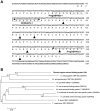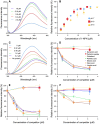Fatty acid solubilizer from the oral disk of the blowfly
- PMID: 23326317
- PMCID: PMC3543412
- DOI: 10.1371/journal.pone.0051779
Fatty acid solubilizer from the oral disk of the blowfly
Abstract
Background: Blowflies are economic pests of the wool industry and potential vectors for epidemics. The establishment of a pesticide-free, environmentally friendly blowfly control strategy is necessary. Blowflies must feed on meat in order to initiate the cascade of events that are involved in reproduction including juvenile hormone synthesis, vitellogenesis, and mating. During feeding blowflies regurgitate salivary lipase, which may play a role in releasing fatty acids from triglycerides that are found in food. However, long-chain fatty acids show low solubility in aqueous solutions. In order to solubilize and ingest the released hydrophobic fatty acids, the blowflies must use a solubilizer.
Methodology: We applied native PAGE, Edman degradation, cDNA cloning, and RT-PCR to characterize a protein that accumulated in the oral disk of the black blowfly, Phormia regina. In situ hybridization was carried out to localize the expression at the cellular level. A fluorescence competitive binding assay was used to identify potential ligands of this protein.
Conclusion: A protein newly identified from P. regina (PregOBP56a) belonged to the classic odorant-binding protein (OBP) family. This gene was expressed in a cluster of cells that was localized between pseudotracheae on the oral disk, which are not accessory cells of the taste peg chemosensory sensilla that normally synthesize OBPs. At pH 7 and pH 6, PregOBP56a bound palmitic, stearic, oleic, and linoleic acids, that are mainly found in chicken meat. The binding affinity of PregOBP56a decreased at pH 5. We propose that PregOBP56a is a protein that solubilizes fatty acids during feeding and subsequently helps to deliver the fatty acids to the midgut where it may help in the process of reproduction. As such, PregOBP56a is a potential molecular target for controlling the blowfly.
Conflict of interest statement
Figures





Similar articles
-
Characterization of antennal chemosensilla and associated odorant binding as well as chemosensory proteins in the Eupeodes corollae (Diptera: Syrphidae).J Insect Physiol. 2019 Feb-Mar;113:49-58. doi: 10.1016/j.jinsphys.2018.08.002. Epub 2018 Aug 3. J Insect Physiol. 2019. PMID: 30080999
-
Odorant Binding Proteins and Chemosensory Proteins in Episyrphus balteatus (Diptera: Syrphidae): Molecular Cloning, Expression Profiling, and Gene Evolution.J Insect Sci. 2020 Jul 1;20(4):15. doi: 10.1093/jisesa/ieaa065. J Insect Sci. 2020. PMID: 32770251 Free PMC article.
-
Identification of odorant binding proteins in Carpomya vesuviana and their binding affinity to the male-borne semiochemicals and host plant volatiles.J Insect Physiol. 2017 Jul;100:100-107. doi: 10.1016/j.jinsphys.2017.05.013. Epub 2017 May 29. J Insect Physiol. 2017. PMID: 28571710
-
The 40-Year Mystery of Insect Odorant-Binding Proteins.Biomolecules. 2021 Mar 30;11(4):509. doi: 10.3390/biom11040509. Biomolecules. 2021. PMID: 33808208 Free PMC article. Review.
-
Two Minus-C odorant binding proteins from Helicoverpa armigera display higher ligand binding affinity at acidic pH than neutral pH.J Insect Physiol. 2013 Mar;59(3):263-72. doi: 10.1016/j.jinsphys.2012.12.004. Epub 2013 Jan 4. J Insect Physiol. 2013. PMID: 23295622
Cited by
-
Transcriptome sequencing of Tessaratoma papillosa antennae to identify and analyze expression patterns of putative olfaction genes.Sci Rep. 2017 Jun 8;7(1):3070. doi: 10.1038/s41598-017-03306-7. Sci Rep. 2017. PMID: 28596537 Free PMC article.
-
Transcriptome analysis and identification of genes related to environmental adaptation of Grylloprimevala jilina Zhou & Ren 2023.Ecol Evol. 2023 Nov 20;13(11):e10717. doi: 10.1002/ece3.10717. eCollection 2023 Nov. Ecol Evol. 2023. PMID: 38020696 Free PMC article.
-
Young Goji Fruit Volatiles Regulate the Oviposition Behavior and Chemosensory Gene Expression of Gravid Female Neoceratitis asiatica.Int J Mol Sci. 2024 Dec 10;25(24):13249. doi: 10.3390/ijms252413249. Int J Mol Sci. 2024. PMID: 39769014 Free PMC article.
-
Aedes aegypti Odorant Binding Protein 22 selectively binds fatty acids through a conformational change in its C-terminal tail.Sci Rep. 2020 Feb 24;10(1):3300. doi: 10.1038/s41598-020-60242-9. Sci Rep. 2020. PMID: 32094450 Free PMC article.
-
Niemann-Pick type C2 protein mediating chemical communication in the worker ant.Proc Natl Acad Sci U S A. 2014 Mar 11;111(10):3847-52. doi: 10.1073/pnas.1323928111. Epub 2014 Feb 24. Proc Natl Acad Sci U S A. 2014. PMID: 24567405 Free PMC article.
References
-
- Hayashi T, Watanabe H, Watanabe M, Kobayashi M (2012) Mass occurrence of flies and seasonal changes in their species composition in the Tsunami disaster region after 2011 the Great East Japan Earthquake. Med Entomol Zool 63: 85–89.
-
- Knipling EF, Rainwater HT (1937) Species and incidence of dipterous larvae concerned in wound myiasis. J Parasitol 23: 451–455.
-
- Tellam RL, Bowles VM (1997) Control blowfly strike in sheep: current strategies and future prospects. Internatinal J Parasitol 27: 261–273. - PubMed
-
- Levot GW (1995) Resistance and the control of sheep ectoparasites. Int J Parasitol 25: 1355–1362. - PubMed
Publication types
MeSH terms
Substances
Associated data
- Actions
Grants and funding
LinkOut - more resources
Full Text Sources
Other Literature Sources
Research Materials

